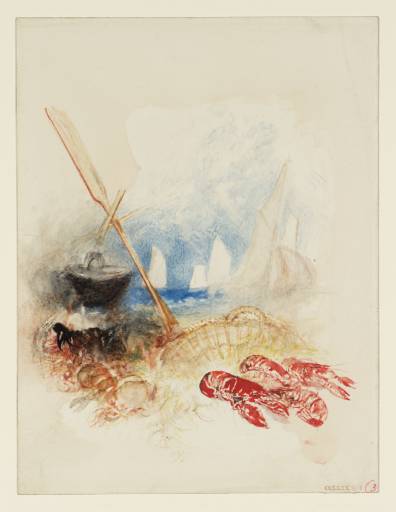Joseph Mallord William Turner Study for Unidentified Vignettes: Lobsters on the Beach c.1835
Joseph Mallord William Turner,
Study for Unidentified Vignettes: Lobsters on the Beach
c.1835
Joseph Mallord William Turner 1775–1851
Study for Unidentified Vignettes: Lobsters on the Beach circa 1835
D27520
Turner Bequest CCLXXX 3
Turner Bequest CCLXXX 3
Pencil, watercolour, and gouache on board, 202 x 153 mm
Inscribed by John Ruskin in red ink ‘(3’ bottom right
Stamped in black ‘CCLXXX 3’ bottom right
Inscribed by John Ruskin in red ink ‘(3’ bottom right
Stamped in black ‘CCLXXX 3’ bottom right
Accepted by the nation as part of the Turner Bequest 1856
Exhibition history
1936
Four Screens, British Museum, London, July 1936–February 1937 (no catalogue but numbered 3).
1974
Turner 1775–1851, Royal Academy, London, November 1974–March 1975 (413).
1975
Turner 1775–1851: zhivopis', risunok, akvarel', Hermitage Museum, Leningrad, October–November 1975, Pushkin Museum, Moscow, December 1975–January 1976 (50).
1982
Turner and the Sea: Watercolours from the Turner Bequest, Loaned by the British Museum, Tate Gallery, London, January–June 1982 (no catalogue).
References
1909
A.J. Finberg, A Complete Inventory of the Drawings in the Turner Bequest, London 1909, vol.II, p.891, as ‘Lobsters on the beach. Not engraved’.
1974
Martin Butlin, Andrew Wilton and John Gage, Turner 1775–1851, exhibition catalogue, Royal Academy, London 1974, p.120 no.413.
1987
John Gage, J.M.W. Turner: ‘A Wonderful Range of Mind’, New Haven and London 1987, pp.230, 231 reproduced in colour, fig.317 bottom right.
1993
Jan Piggott, Turner’s Vignettes, exhibition catalogue, Tate Gallery, London 1993, pp.90, 95.
The subject of this vignette combines landscape elements with a carefully composed still-life. Crabs, mussels and other examples of seafood appear underneath a large black cooking pot and a tripod of oars. The immediate foreground is dominated by a catch of bright red lobsters (apparently already cooked) resting in a wicker basket. In the background are the silhouettes of a number of sailing boats, presumably fishing vessels. The illustration belongs to a group of four finished designs that Turner produced for an unidentified project (see also Tate D27521; Turner Bequest CCLXXX 4, Tate D25465; Turner Bequest CCLXIII 342 and Tate D25466; Turner Bequest CCLXIII 343). The other designs retain a similar format and depict cod, sprats, plaice, and mackerel respectively. None of the watercolours were ever engraved for publication.
Although the theme, palette and style of the four vignettes suggest that they are related, the nature and circumstances of that connection has not yet been established. Turner possibly produced the series during the mid 1830s, at a time when he was renewing his interest in marine subjects.1 The group was recorded by Ruskin in the National Gallery Archive Schedule of 1854 as ‘Parcel 62’ and described as ‘containing 4 finished vignettes for Mr Bicknell’.2 Elhanan Bicknell (1788–1861) was a businessman who made his fortune in the Southern Sperm Whale fishery and became an important patron of Turner’s.3 He bought his first works by the artist in 1838 but is most famously remembered as commissioning at least two of the artist’s four late oil paintings of whaling subjects, Whalers 1845 (Tate, N00545) and Whalers (The Whale Ship) 1845 (Metropolitan Museum of Art, New York).4 There is no further evidence however, of his involvement with these four fishing vignettes.
Jan Piggott has suggested that the four designs may have been intended to serve as chapter headings for an unidentified publication on deep-sea fishing, with each plate introducing a different type of catch.5 Stylistically, the designs also resemble Turner’s title vignettes for his Rivers of France series (1833–5) and may be related to that group of works.6 More recently, Ian Warrell has suggested that the series may be connected to an unrealised engraving project, The English Channel, or La Manche, a scheme on which Turner appears to have been working in 1827.7 According to an advertising prospectus this serialised publication was to combine topographical British and French coastal views with vignette illustrations and these four fanciful scenes of the bounty of the sea may have been intended to act as head- or tail-pieces to the individual sections. If this is the case, however, this means that the designs would pre-date those of Rogers’s Italy, Turner’s first sustained vignette project.
Whatever the reason for their creation the four illustrations reflect the artist’s particular interest in marine subjects and his lifelong love of fishing. There are a number of accounts which testify to his regular participation in the activity and a fishing rod once owned by him is amongst a number of personal items in an archival collection at Tate (L01139, lent by the Royal Academy of Arts). He also made a number of watercolour studies of fish which are unusual examples of detailed still-life painting by the artist (see Tate D25461 and D25462; Turner Bequest CCLXIII 338 and 339).8
James Hamilton, Turner: The Late Seascapes, exhibition catalogue, Sterling and Francine Clark Art Institute, Williamstown 2003, p.115.
Evelyn Joll ‘Elhanan Bicknell’, in Evelyn Joll, Martin Butlin and Luke Herrmann (eds.), The Oxford Companion to J.M.W. Turner, Oxford 2001, p.24.
Martin Butlin and Evelyn Joll, The Paintings of J.M.W. Turner, revised ed., New Haven and London 1984, nos.414 and 415.
Martin Butlin, Andrew Wilton and John Gage, Turner 1775–1851, exhibition catalogue, Royal Academy, London 1974, p.120
Verso:
Inscribed by an unknown hand in pencil ‘120 | b’ centre right
Stamped in black ‘CCLXXX 3’ lower left
Stamped in black ‘CCLXXX 3’ lower left
Meredith Gamer
August 2006
Revised by Nicola Moorby
August 2008
How to cite
Meredith Gamer, ‘Study for Unidentified Vignettes: Lobsters on the Beach c.1835 by Joseph Mallord William Turner’, catalogue entry, August 2006, revised by Nicola Moorby, August 2008, in David Blayney Brown (ed.), J.M.W. Turner: Sketchbooks, Drawings and Watercolours, Tate Research Publication, December 2012, https://www

